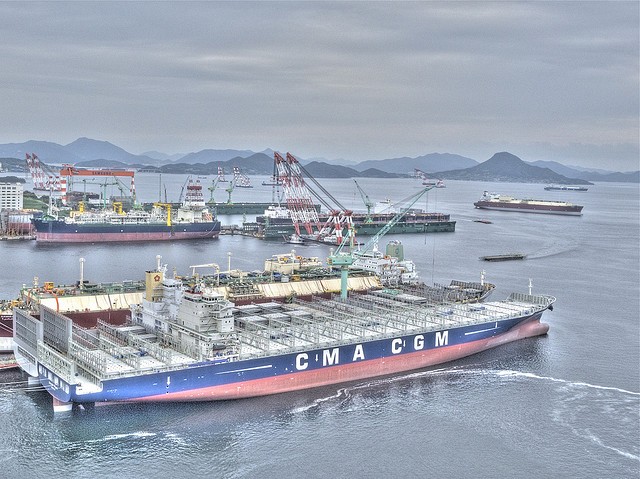
Samsung Shipyard in Geoje, South Korea courtesy Flickr user gCaptain
Recession’s Lagging Effect on Orders Forces South Korean Shipbuilders to Cut Payrolls, Shift Course
By Evan Ramstad
ULSAN, South Korea—While companies around the world are bouncing back from the global recession, shipyards are just now starting to see its effects.
Orders have plunged, prompting shipbuilders to slash payrolls and shift toward building drilling rigs and other offshore products for the energy industry.
The reason for the recession’s lagging effect on shipbuilding is peculiar to the industry. A decline in world trade and shipping three years ago cut demand for ships. But because big tankers and container vessels take three to four years to build, shipyards kept busy filling orders received before the financial crisis.
Orders for ships sank in 2009 and recovery has been slow, although analysts expect orders to increase later this year.
The downturn is affecting shipyards world-wide. China’s shipbuilding association last month said some of the country’s yards would suspend production after completing existing orders.
But the impact is especially deep in South Korea, home to six of the world’s 10 largest shipbuilders by sales. Ships are the country’s biggest export, accounting for 15% of total exports at an estimated $25 billion through May, according to the Korean government.
The situation at the world’s largest shipbuilder is typical. At the end of 2008, Hyundai Heavy Industries Co. reported an order backlog of 350 ships. Hyundai Heavy had enough work to operate at full capacity through this year. Production this year will be a record: 110 ships at two ports in South Korea.
The company received orders for just 10 small military ships in 2009, however, and 57 ships of various types last year. While sales are picking up—the company forecast that orders will about double this year to more than $7 billion—ships ordered now won’t start being assembled for at least two years. Even though the order backlog has evaporated, ship construction can only speed up to a small degree. The several-year process of designing and building a ship is largely immutable.
With the global economy still fragile and financing prospects uncertain, it will be several years until orders are back to normal, people in the industry say.
That has meant ship prices are far lower than what they were in 2007. And to avoid a complete drop in shipyard activity, major shipbuilders deferred some deliveries that had been promised for 2010 and this year.
“It’s absolutely a buyers’ market,” says Gerry Wang, chief executive of Seaspan Corp., a Hong Kong-based charter owner of container ships. “The shipbuilders need orders to fill up the docks. They are very, very hungry.”
Even a hint that an order is in the works can make news. Word that Seaspan was considering placing a $2.7 billion order with South Korea’s STX Offshore & Shipbuilding Co. sent the builder’s shares up more than 7% on one day in April.
To cope with the slowdown, shipbuilders have reduced payrolls, chiefly by letting contracts lapse for contract workers.
Daewoo Shipbuilding & Marine Engineering Co., the world’s second-largest maker by revenue, has about 2,000 fewer contract workers than the 18,000 it had at the start of the year. DSME has forecast 2012 revenue of $10.2 billion, down 8% from this year. The company hasn’t trimmed its permanent staff of 12,000, however, and expects to begin rehiring again next year, says board secretary C.S. Lee.
Smaller shipbuilders also are feeling the pinch. Hanjin Heavy Industries Co. laid off about 600 workers this year and shifted much of its production to a yard in the Philippines. Five midsize Korean shipbuilders closed last year, and among the roughly 15 midsize shipbuilders that remain, employment is down about 30% from the 2008 peak, says Kwon Young-won of the South Korea Research Institute of Medium & Small Shipbuilding.
Shipbuilders also are seeking to build windmills, drilling platforms and other massive offshore products for the energy industry.
DSME has been reassigning ship-design engineers to work on offshore projects. Under the water’s surface, the design principles are the same, says Kim Man-soo, vice president of hull design. But offshore rigs and floating refineries are far more sophisticated above surface, which means engineers must develop new skills.
The shift has affected hiring. “In the past, we recruited students who majored in shipbuilding and naval architecture,” Mr. Kim says. “Now, we’re looking at students with majors in chemistry and geology and other skills for the topside.”
Hyundai Heavy this year transferred about 100 engineers and 300 shipyard workers to offshore projects. The workers were part of a group of 1,000 employees who were transferred away from shipbuilding to other businesses, including a new “green energy” division that produces solar cells. Ships today account for 35% of the company’s revenue, down from 80% a decade ago.
Five years ago, Hyundai Heavy used part of the yard designed for offshore products, such as drilling rigs, to build ships because the main shipyard was overflowing. Now, the situation is reversed. “From the second half of this year, I don’t have room for ships until the end of 2012,” says Kang Chang-june, executive vice president for Hyundai Heavy’s offshore division.
Hyundai Heavy in late April delivered its largest offshore project ever—a floating production, storage and offloading, or FPSO, unit that can store two million barrels of oil and refine 180,000 barrels of oil and five million cubic feet of gas a day.
Such leviathans—about the length of four soccer fields and more than 100 feet high—are towed by large tugboats to their destination, and journeys to Africa and Europe can take four or five months. Mr. Kang is pushing for Hyundai Heavy to build faster vessels in the hopes of winning more FPSO business from impatient energy companies.
(c) 2011 Dow Jones & Company, Inc.

 Join The Club
Join The Club











